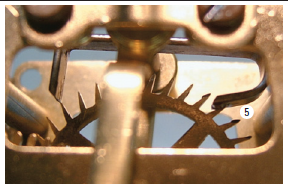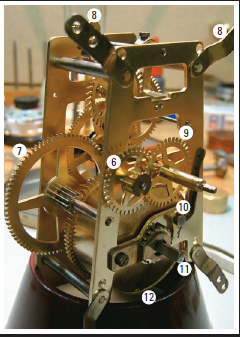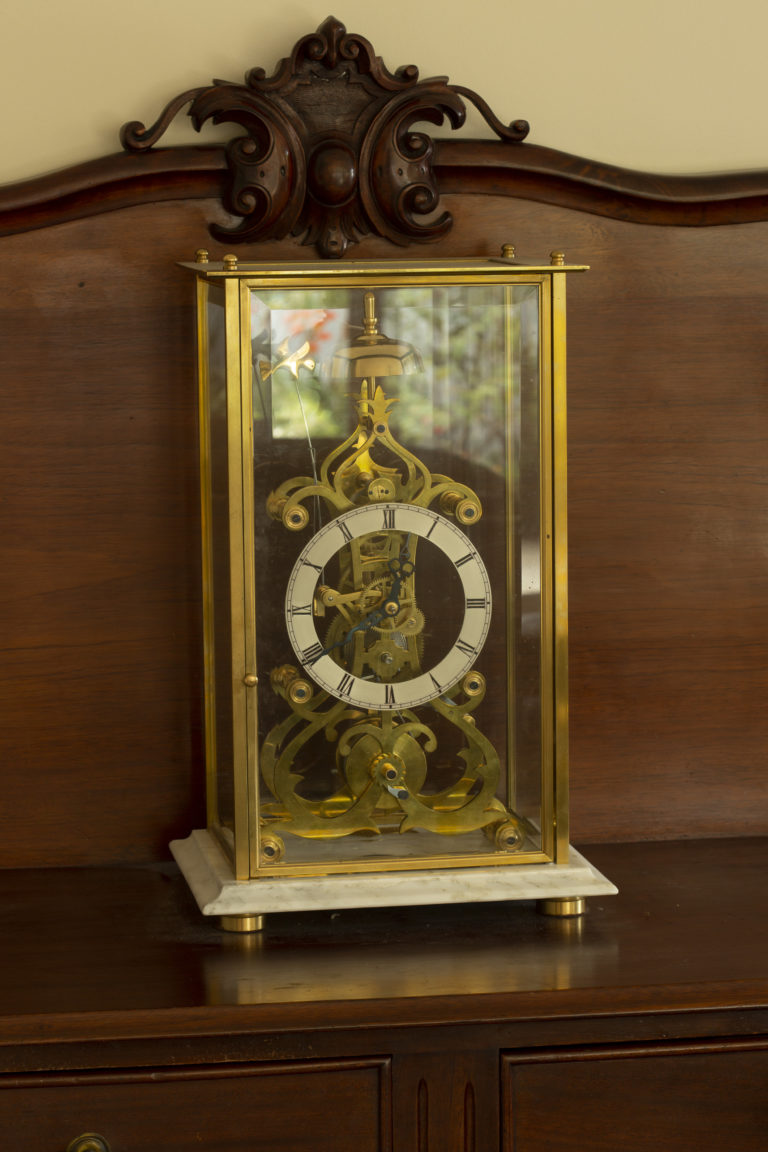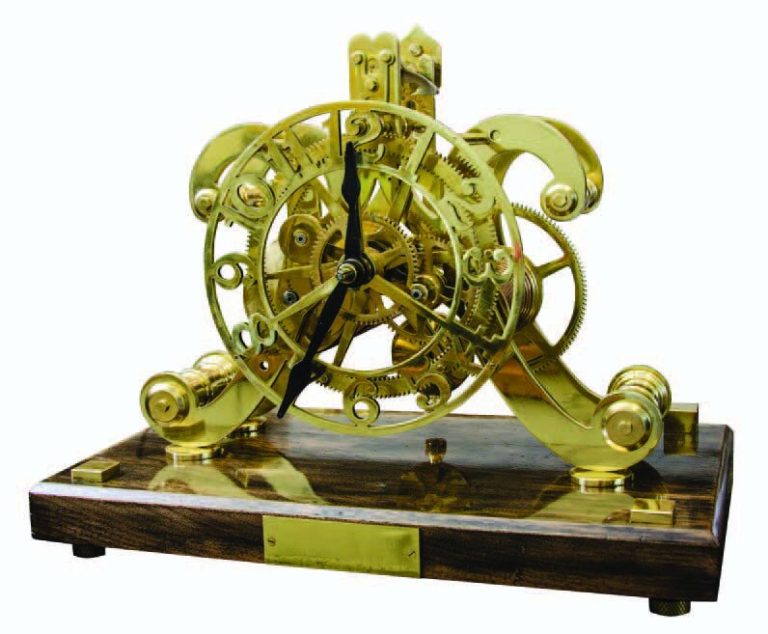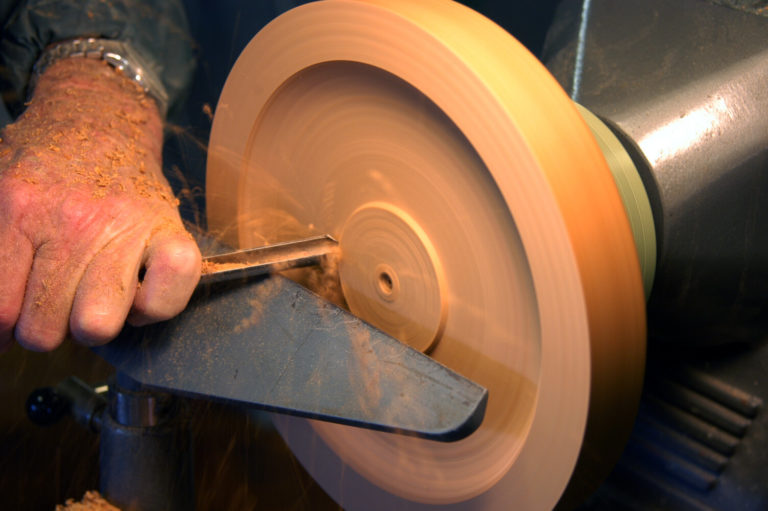In his Bay of Plenty shed, Ken England keeps things ticking along.
By Vivian Edwards
Photographs: Vivian Edwards
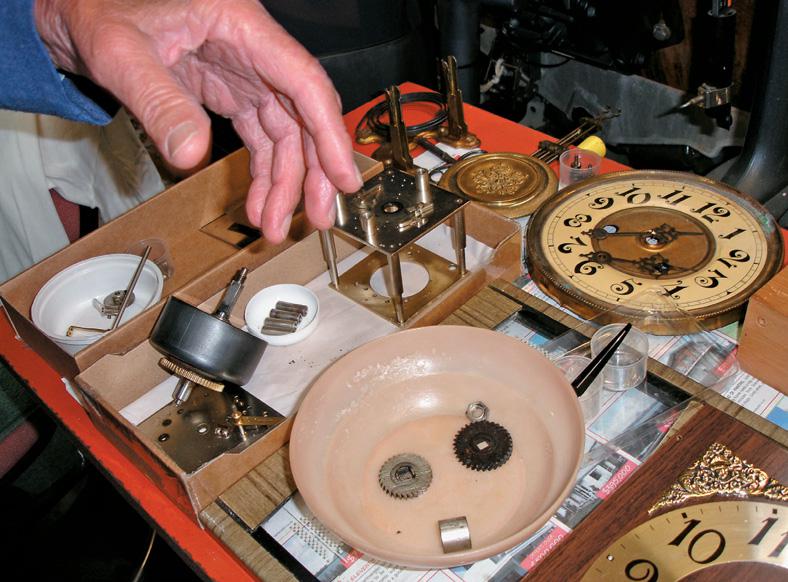
Ken England has been fixing clocks as a hobby in his Whakatane shed since the 90s.
Repairing a clock is not just a case of pulling it to bits, replacing parts then re-assembling, he tells me. “Everything works in sequence and has to be timed.”
He is a member of the New Zealand Horological Institute but was never a clockmaker by trade. What makes Ken “tick” and has given him the necessary clock-repair skills is the engineering know-how already in his background, a knowledge of how to machine parts, manufacture, and silver-solder.
Ken grew up in Christchurch where the family had settled. He tells me his grandmother was carried in her mother’s arms on a donkey from Lyttelton to Christchurch via the well-known bridle path over the Port Hills and that, until the Depression years, the England family owned a good portion of Canterbury land.
Mechanic
He always wanted to be a watchmaker. But his father owned a garage so he trained as a motor
mechanic then sat advanced trade and other certificates. After leaving the garage, he was contracted to the Air Department who wanted a multi-skilled person to work as a diesel and electrical engineer responsible for maintaining the 230- volt diesel generators and electrical
system for the Weather Office on Raoul Island.
“The work varied from using a bulldozer to repairing wristwatches and fishing.” After working around the Pacific, Ken returned to New Zealand, married, and became VW Motors service
manager. When his wife died, he went away for a time then later joined National Airways Corporation (NAC) and became a qualified aircraft tradesman. At Harewood airport in Christchurch, he worked on Viscounts, Friendships, and DC3s, then in the instrument shop.
But Ken could see no future in this career and felt his creativity stifled. “You don’t learn much working on aircraft. For safety reasons, you are not allowed to manufacture or repair. Everything has to be new.
A screw or rivet dropped on the floor cannot be picked up and used in case it is the wrong one.”
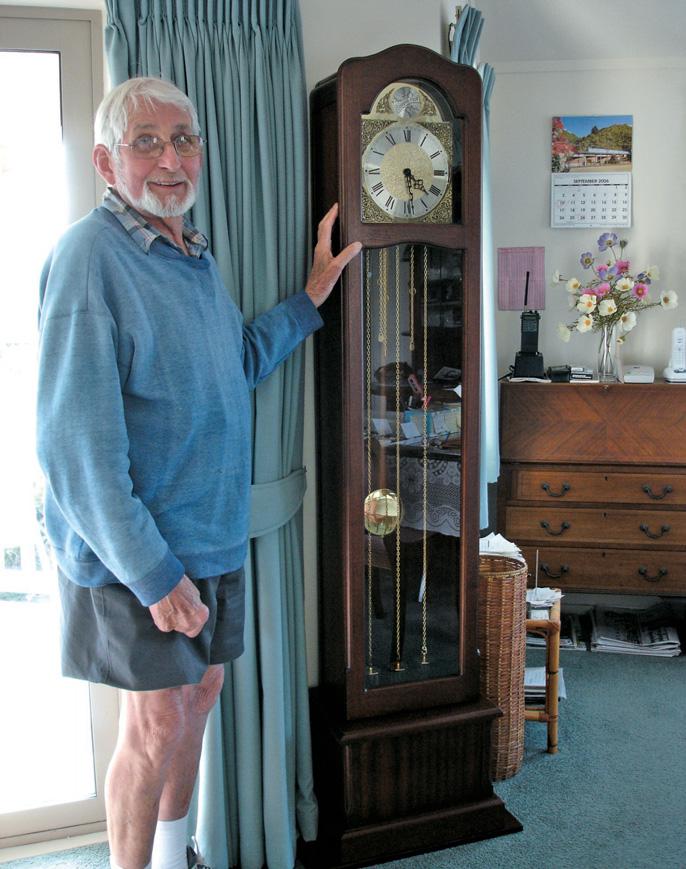
Auto-electrical
Ken left NAC and started his own auto-electrical business, initially from a big shed at his Kaiapoi
home. He serviced trucks after hours when no one else wanted to work and in two years had sufficient money to build a new workshop on the main road.
Calibrating speedometers, fixing car clocks and instruments helped Ken gain agencies for GMC (General Motors) Autolight Delco Remy equipment, and for Smith’s speedometers and clocks. Having cornered most of the North Canterbury battery market, he was offered and took up the Lucas agency. Ken chose his apprentices on their ability to read and comprehend a manual, write an easily understood letter and do basic maths.
Ken asked mothers to see their son’s bedrooms, not for tidiness, but for signs of creativity like model cars and airplanes. For extra training outside the trade, his apprentices did conversions, putting V6 motors and automatic gearboxes into Land Rovers for people going skiing.
But after ten years in business, Ken became seriously ill with a lung infection. Princess Margaret Hospital’s chief respiratory physician told him to get out of Christchurch’s winter smog and work outside or he would be “planted.” Ken took his advice.
He designed and built an articulated caravan towed with a converted V6 Land Rover truck, then he and his second wife traveled around the North Island for a year before settling in Whakatane where he decided to open a motor camp.
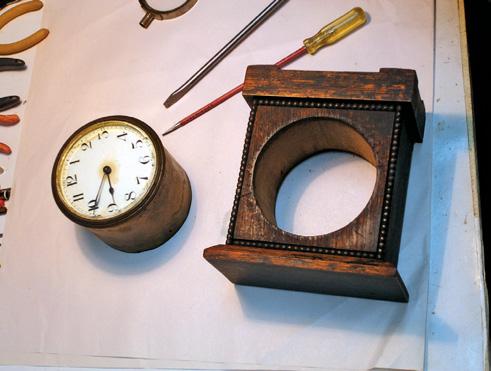
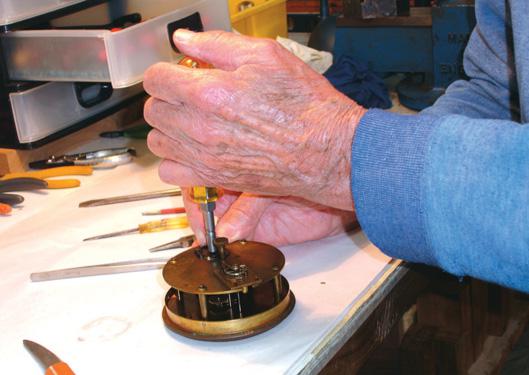
Motor camp
The Council, under pressure for five years from locals upset over people camping by the Port Ohope toilets, had twice unsuccessfully balloted out a plan to build a motor camp. Ken had to prove he had $40,000 for the Crown lease in perpetuity. He started building in August and by Christmas had the camp running. He and his wife sold it 20 years later.
Retirement was short-lived and Ken converted a big old dwelling to a guesthouse. He finally retired after selling three years later. He got into clocks through a fellow tramper’s husband. The man fixed clocks but was losing his eyesight. He also lacked tools whereas Ken kept a good workshop. Once Ken helped out by drilling a hole in a clock spring for him, he gradually took over all his clock work.
The clocks too have taken over, ticking and chiming from all directions – in the lounge, the spare room, and Ken’s garage workshop. Each clock tells a story. A French clock was owned by a lady who had been on the London stage. She stayed with them in the guesthouse. Ken shows me a 130-year-old cuckoo clock, and the “grandmother” clock that he designed and made, although a cabinetmaker now manufactures a case to Ken’s specifications. “You would find it difficult to buy a tall case clock because people don’t usually sell them. They hand them down”
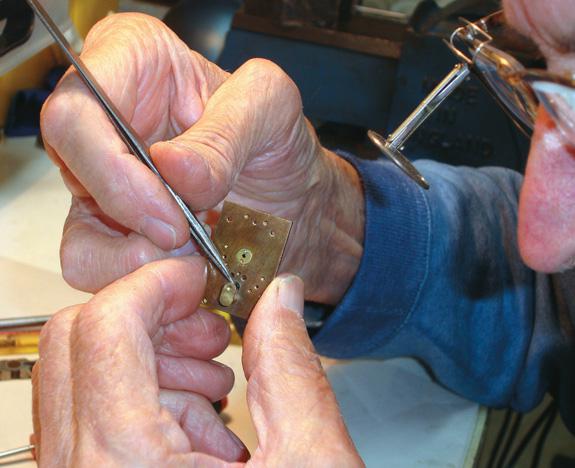
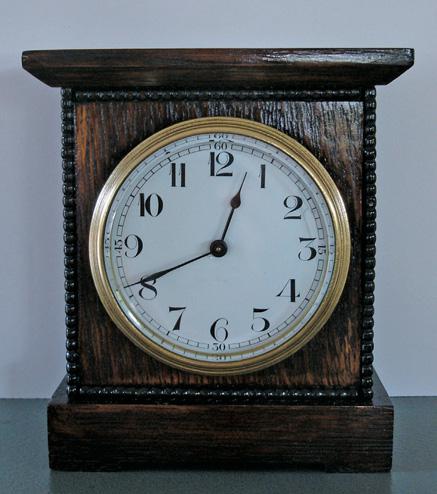
Pendulum arc
Ken has to calculate the swing of the pendulum which drives the clock by gravity. From the gauge
and length of the pendulum, he calculates its arc using trigonometry.
“The tangent of angle for a big grandfather clock will be somewhere between 2 ½ and 4 ½ degrees. If there is an insufficient swing there won’t be enough energy.”
Looking at Ken’s workshop tools he must have inherited a good length of No 8 wire, for he has been inventive whenever the need arose. To save his knuckles, for example, Ken attached a doorknob to a difficult-to-handle key for drawing down clock springs. On the lathe he uses for pivot-polishing, instead of having to change belts for speed control he fitted an extra motor taken from a washing machine.
And to his clockmaker’s lathe, he fitted an electronic speed controller of his own design. This speed control system uses a thyristor, a semiconductor device with a control circuit that acts as a switch. When the load comes on, the rising voltage feeds back into the thyristor causing the motor to remain torque-stable.
Back in his Kaiapoi business, Ken had previously designed a hi-tech control system with two amplifications on his speedometer-calibrating machine. “Without stable torque-control, the speedo would change speed when we were working on it as the load on the motor changed.”
Speedometers use magnetism and a hairspring. American speedos were set to 500 revs for 30 miles per hour (48km/hr) and 1000 revs for 60 mph (96km/hr). Calibration of those two speeds meant using the knee to tap a demagnetising button attached to the bench, then adjusting the hairspring tension to move the needle to the correct speed limit.
Ken also worked on a rain gauge used for school demonstrations in Matata. A 30-day paper tape revolving on a drum is marked by an ink pencil moving up and down, depending on the amount of water falling into a cup. At the end of each 24-hour period, the cup empties and the pen falls to the bottom.
The man who owns the gauge also has a sunshine recorder and other equipment. Ken shows me under a magnifying glass there is corrosion in the rain gauge but the pivots have enough oil and are spared.
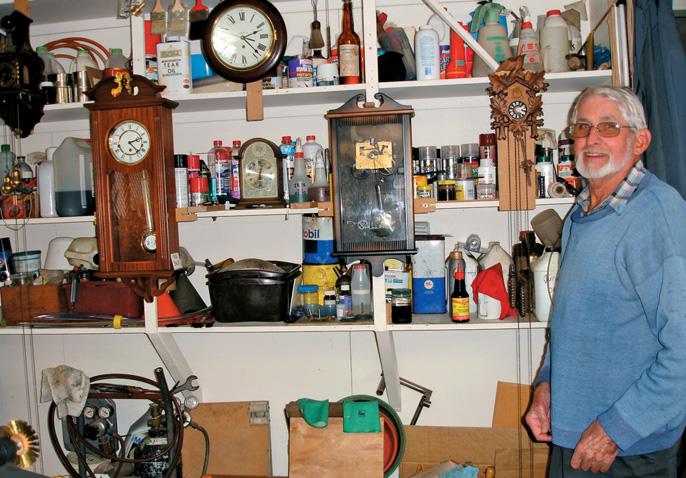
Clocks
But clocks are now Ken’s main interest and I’ve brought him one that came to me after my grandfather died. I know nothing of the clock’s history. It still works but gains an hour a day so I don’t wind it often. Ken tells me the clock is more than 100 years old and is worth restoring.
Inside there is a platform escapement – the self-contained device controlling the speed of the clock, consisting of a balance wheel, pallets, escape wheel, and, a hairspring mounted between two
flat brass plates. The movement is Swiss.
The brass sleeve containing the clock workings has to come out of its cabinet, but after a century together the two are not easily separated. The screws from the sleeve go into a pot to keep them together, and away from the parts of other clocks. Screw holes and screw heads are worn. Ken takes off the platform. Inside, the clock is filthy, so the movement needs soaking and cleaning, but the clock is in reasonable working order. There is little gear wear. The number of jewels in a clock signifies quality.
Here, the escapement has only two jewels but there are jewel pallets, whereas another clock he is working on has twelve jewels.
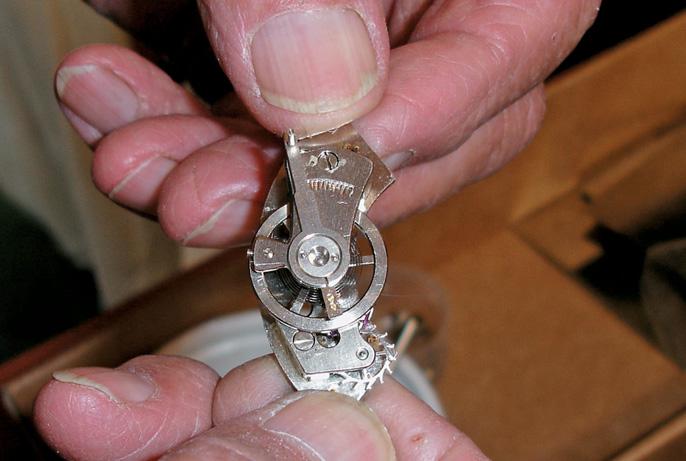
Hermle
Ken shows me an early chiming clock with a floating escapement made by German manufacturers
Hermle. He tells me the invention of a floating escapement allowed a previously immobile (pendulum) clock to be moved around and that Hermle manufacture was similar to today’s assembly-line-workers knew only how to make one individual part.
They were unable to go out and start their own clock manufacturing business in opposition, whereas American clocks were stamped out of sheet brass and mass production led to the US
industry’s downfall.
The chiming clock plays three tunes, differing for the quarter, half, and three-quarter hour. A timed
sequence of wheel-turning, lever-lifting and a pin dropping into slots warns, then turns, the drum so the hammers hit the chime bars with the right tune that tells the time. In more technical terms, when the shaft connected to the hand turns, the four arms (the cannon pinion) lifts the flirt (a little piece of metal). The flirt unlocks the warning wheel, which then spins to the warning position. When the cannon pinion releases the flirt the warning pinion is released, allowing the clock to chime.
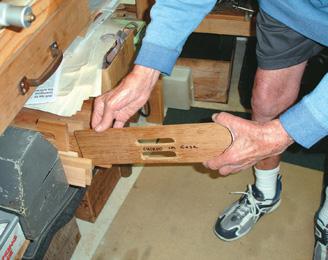
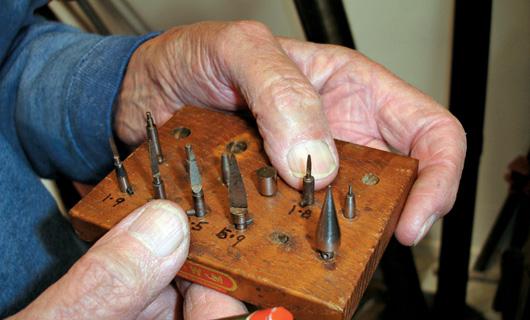
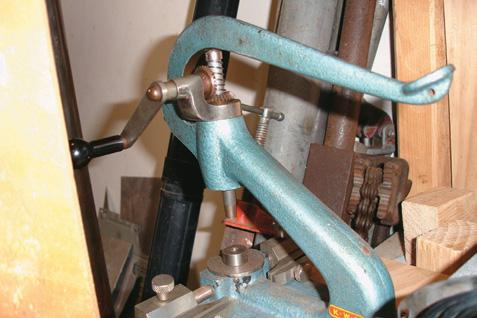
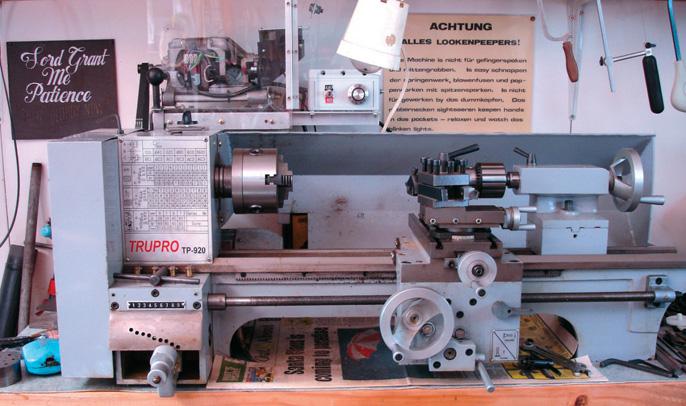
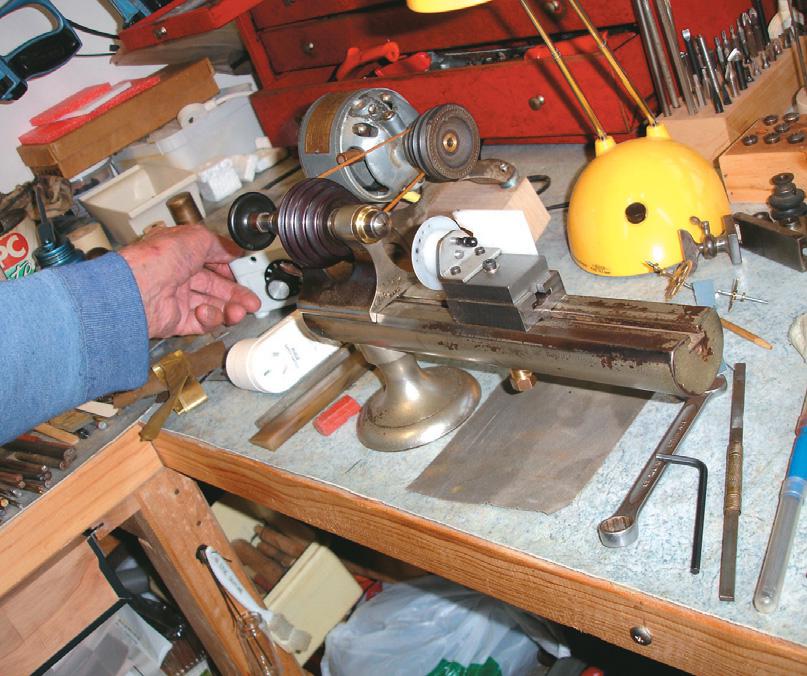
Trial and error
When Ken later works on my clock he replaces the old steel hairspring with one made of Invar steel that does not vary with temperature and humidity. The old hairspring was physically damaged, which explains the imperfect time-keeping, and it was probably not the original
hairspring. The new hairspring is not operating as it should. It may not be the right one for my clock and Ken will replace it with a finer spring.
He has smartened the exterior, built a new back cover, stripped the cabinet, covered it with shellac,
and waxed it for protection. Ken tells me that there can be trial and error and guesswork in fixing
old clocks and to understand how everything works together takes experience. He has now repaired enough clocks to have a fair idea of where everything goes.
For unfamiliar clocks, he makes notes and takes photos beforehand. He says extra repairs can be necessary when people try to fix their own clocks. He has seen clocks where the wood has been ruined by sandblasting, movements have been sprayed and jammed with CRC, or faces obliterated through household cleaners.
My old clock is now back home with me. It looks smart and keeps good time, but unlike Ken, I need to constantly remind myself to rewind it.
HOW CLOCKS WORK
By Blair Shallard MNZHI
A clock is a machine for measuring the passage of time. Like all machines, it requires some sort of motive force; in this case, either a weight or spring. It requires a gearbox of sorts; the gear train. It requires something to regulate the speed of the machine; the escapement, and finally it needs some way to relay the outcome of all this activity to the user; the face. To understand the whole, we must understand the individual parts.
Motive force
The power supply has a relatively simple job to do. It must make wheels turn. If you think of a pushbike, and how a chain wrapped around a cogwheel is pulled causing rotational motion, you are well on the way to understanding a weight-driven clock. A weight is suspended on the end of a cord, which is wrapped around a winding drum attached to the first wheel. Gravity pulls the weight down and it, in turn, rotates the gear train.
Spring clocks use a long strip of spring steel coiled inside a housing called a barrel. The barrel itself is toothed and forms the first wheel. The outer end of the spring is hooked to the inside of the barrel, and the inner end is hooked to the axle of the barrel, called the winding arbor. When the clock is wound up, the spring is wrapped tightly around the arbor, and as it attempts to straighten itself out by unwinding, it causes the barrel to rotate.
Gear train
This gives a clock its duration and consists of wheels driving pinions, a pinion being a wheel with 12 teeth or less. With the exception of the first wheel, each arbor (axle) has both a pinion, which receives the power and a wheel, which transmits it to the next arbor. In ordinary parlance, we just tend to refer to the wheels. So, in a clock geared for eight days the first, or great wheel, turns the intermediate wheel, which turns the centre wheel, which turns the fourth wheel, which finally turns
the escape wheel, the last wheel in the sequence. By adding extra intermediate wheels we can increase the duration to a month or even a year. All these wheels turn in a frame of two brass plates supported by four or more pillars.
Escapement
This is the heart of the clock, and the most common type used in clocks is called the recoil escapement. It consists of the escape wheel, which has wedge-shaped teeth and mounted above it, the anchor, which is attached to the pendulum through a linkage. The anchor also called the pallets, seesaws as the pendulum swings from side to side.
As the pendulum swings up from centre, the pallet nib opposite the direction of swing drops down and locks the escape wheel, rotating it backwards slightly. As the pendulum swings back, it is pushed by the rotational force of the escape-wheel tooth pushing on the nib before the tooth unlocks and another tooth is locked by the other pallet. This impulse is what keeps the pendulum swinging.
The distinctive ‘tick tock’ sound of the recoil escapement is caused by the escape wheel teeth locking against the two differently-shaped pallet nibs.
Pendulum
The rate of the clock is set by the length of the pendulum, which hangs on a thin strip of spring steel called the suspension spring.
A short pendulum will swing quickly while a longer one will beat more slowly. The gear train is matched to the pendulum length to give an accurate measurement of time. Fine tuning is achieved by turning the rating nut to either raise or lower the bob.
Face
This consists of the dial and hands. The hands are mounted on the extended front arbor of the centre wheel via some additional gearing called the motion work which gives the hour and minute hands their correct ratios. The hands must be mounted friction-tight so they can be set without turning the whole gear train.
Complications
This is the name given to anything other than the gear train described. The most common complications are chiming the quarter hours and striking the hours, each requiring a separate gear train.

